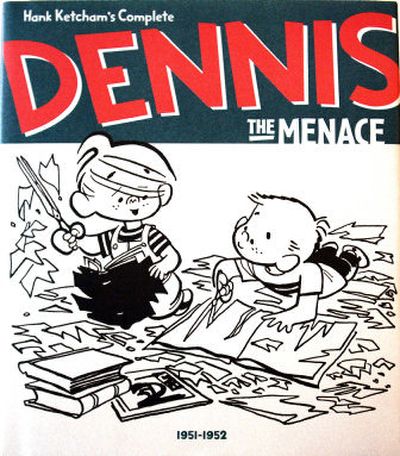Fantagraphics reviving ‘Dennis the Menace’

“Peanuts” turned to gold for Fantagraphics. Now the once-struggling comics publisher hopes another cartoon icon, “Dennis the Menace,” can follow in Charlie Brown’s footsteps.
Fantagraphics will publish the first book in a 25-volume series, “Hank Ketcham’s Complete Dennis the Menace,” in early September. The series will run 11 years and reprint every “Dennis the Menace” newspaper strip drawn by Ketcham – nearly 11,000 strips spanning more than 44 years.
The 624-page first volume will reprint the first two years (1951-52) of the cartoon life of the mischievous lad who bedevils his parents and neighbors.
The company also will republish Ketcham’s autobiography as a companion to the first volume. The cartoonist was born in Seattle and died in 2001 at age 81.
“Dennis is everybody’s kid,” says Ketcham’s widow, Rolande. “He’s a lovable guy who gets into trouble but in a nice way.”
She had never heard of Fantagraphics until she saw its “Peanuts” anthology and its proposal to reprint “Dennis.”
“They did a lovely job on ‘Peanuts,’ and we are quite flattered that they are doing ‘Dennis,’ too,” she says.
Fantagraphics was on the verge of going broke just two years ago. Four best-selling “Peanuts” reprint editions and a boom in the graphic novel industry helped turn around the struggling Seattle company.
“Compared to where we were two years ago, we’re quite prosperous now,” says company president Gary Groth.
The first volume of “The Complete Peanuts” was published in spring 2004 and has since sold 110,000 copies. It was the first Fantagraphics product to hit The New York Times list of best sellers in the company’s 29 years.
The second volume has more than 100,000 copies in print, and the third and fourth volumes each have more than 80,000. Each volume has a retail list price of $28.95.
Fantagraphics had long been known for underground and alternative comics rather than family fare such as “Peanuts,” but a friendship between “Peanuts” creator Charles Schulz and Groth helped the company land the deal. After Schulz died in 2000, his widow, Jean, helped get the project off the ground.
“She helped us cut through all the red tape and convinced the syndicate that this was a good thing,” Groth says.
Charlie Brown and his pals have an enduring and almost universal appeal.
“He has hope, but knows there is always the possibility of failure,” says M. Thomas Inge, a humanities professor at Randolph-Macon College in Ashland, Va. who has curated exhibits on comics art for the Smithsonian Institute. “He’s a loser, but he’s always trying to get ahead.”
“Dennis the Menace,” on the other hand, persists in being the troublesome child but also has a universality.
“Dennis explores new environments, he challenges parental authority,” Inge says. “We can all relate to him because almost every family has a child like this.”
Marcus Hamilton, who took over the strip after Ketcham retired in 1994, says that the first volume of reprints might surprise longtime fans who view Dennis as a mischievous but harmless little kid.
“The strip was a little more risque when it first started,” he says. For example, in one panel, Dennis tied a swan’s neck in a knot.
Inspired by his “rambunctious” young son, Ketcham created “Dennis” in 1951, and the strip started running in 16 newspapers. It reached 100 papers by the end of its first year, and now Dennis trails only Charlie Brown in cartoon popularity. It appears daily in more than 1,000 newspapers in 48 countries, and is translated into 19 languages.
Ketcham’s autobiography, “The Merchant of Dennis the Menace,” was originally published in 1990. The new version will have vintage photos of his childhood home, family photos, early sketches and many other illustrations.